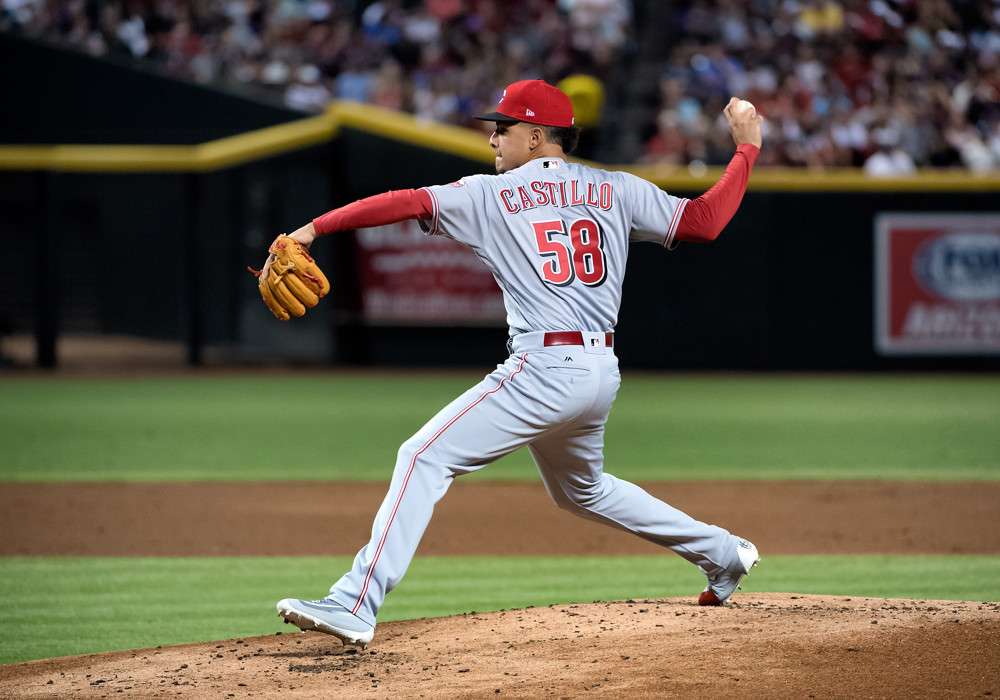
With a couple of weeks of the season now in the books, some early-season performances can start to become meaningful predictors. That said, results-based data (and even batted ball data) have not had enough time to really find their level yet. More granular changes become meaningful more quickly, though, and there is a ton of potential value to be had for owners who identify sustainable early-season breakouts. Case in point: Ketel Marte, a player whose surface numbers were not doing him justice, raised his batting average more than .070 points this week. This week, three players whose early-season results have been extreme (in different ways) and whose underlying numbers offer reason for optimism for all three moving forward.
Jose Berrios’ Location
As a prospect, Berrios was lauded for his potentially devastating fastball-curveball combination. Those two pitches have proven to be his bread-and-butter as a big leaguer, as well, and he has ridden them to spectacular early-season results. Berrios is among the league’s top 30 starting pitchers thus far in innings, ERA, and FIP. He sits behind only Gerrit Cole, Patrick Corbin, and Max Scherzer in strikeout and walk rate differential. He’s currently running career-best swinging strike and ground ball rates, and his curveball has been especially stellar. So what’s to credit for Berrios’ success? Not any change in pure stuff, it seems. His fastball and curveball are virtually identical to last season in terms of velocity and spin rate. Facing the Orioles and the White Sox probably helps, although Chicago has been one of the league’s best offensive teams in the early going.
What Berrios does seem to have legitimately improved is his command. In 2016, Berrios had no idea where his four-seam fastball was going. In 2017, it was consistently over the heart of the plate. This year, Berrios has attacked glove-side and down against right-handed and left-handed hitters alike. He is also clustering his curveball more reliably glove-side and down in the zone. Even his sinker has moved further glove-side than in other seasons. It is not clear whether Berrios has worked glove-side intentionally, but it’s worked for him thus far. With plus stuff, consistently improving command, and an increasingly rare workload capacity, Berrios is not far away from fantasy ace-hood.
Matt Chapman’s Contact Rate
We go from one of the league’s best pitchers to one of its best hitters. Chapman has been the second-best qualified hitter in baseball to this point thanks to a newfound ability to put the ball in play. After punching out in 28.2% of his MLB plate appearances as a rookie, Chapman has struck out just 16.9% of the time to this point. This level of contact almost certainly won’t last; Chapman struck out nearly 30% of the time at every minor-league stop, and his current strikeout rate would be the lowest of any season of his professional career. Because of this, every major projection system sees Chapman as a batting average liability moving forward. Projections are inherently slow to recognize improvement, though, and Chapman is making more contact than expected. His 80% contact rate is actually well above-average so far, and he has made surprising gains in this regard over his brief MLB career. Looking at Chapman’s rolling contact rate graph, the trend is unmistakable. He’s made immense progress already in his bat-to-ball skills, and his batting average has unsurprisingly climbed as well. This is not to say that Chapman will not regress; he won’t finish the season hitting anywhere near .358, of course. His steady progress in his brief big-league career, though, means he may not regress as far as the projections expect him to. With his power and consistent playing time in the middle of Oakland’s order, he does not need to hit .285 to be a viable fantasy asset. His early contact metrics suggest he may be more of a .260 hitter than his projected .230.
Luis Castillo’s Swinging Strike Rate
On the flip side of Berrios and Chapman is Castillo, who currently sports a 7.31 ERA that beats only Julio Teheran’s 7.58 among qualifiers. Castillo’s four home runs allowed are mostly to blame, but his strikeout rate has alarmingly fallen nine percentage points from last season. Altogether, though, Castillo seems fine. His fastball velocity is down two ticks, which is somewhat concerning. However, velocity tends to rise as the season progresses, and Castillo has still averaged a strong 95.8 MPH. More encouragingly, despite the drop-off in strikeout rate, Castillo has not been any easier to touch on a per-pitch basis. Hitters have swung and missed at 14% of Castillo’s total pitches this season, up from 12% last year, and he has done a better job of getting ahead in the count on the first pitch. Altogether, Castillo looks like much the same pitcher he was last season despite his poor results. It’s hard to imagine too many owners cutting bait on him entirely, but this could be a good chance to buy low in trade on a very promising young pitcher.
